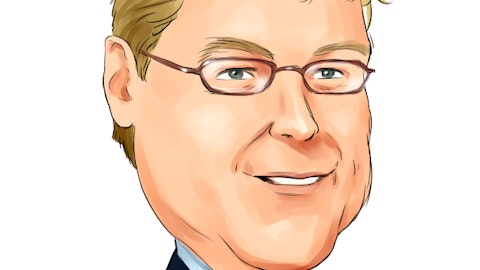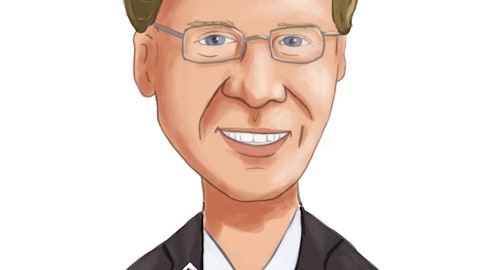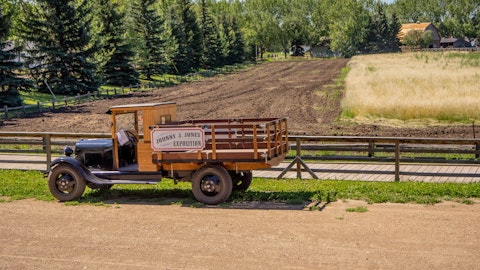Eric Hansotia: Yes, the demand generation is well on track for Fendt in North America and South America, our globalization of the full Fendt product line. We’re step-by-step establishing more and more dealers that meet the stringent qualifications of being a Fendt dealer. And so that’s in place. In reality, we underserved that demand in 2022. We could have sold a lot more, and we’ve actually got a few dealers that are frustrated. They want to grow with this new product line, and we weren’t able to feed that enough. So we’re working very hard in €˜23 to make sure that we can match supply and demand more closely. But so far, what we’re seeing is the Fendt experience, the brand value proposition is being maintained in terms of the best of the best for product and support. The dealers are doing a great job of delivering that. The products are living up to the expectations and it’s really about us just feeding the channel.
Jerry Revich: Okay. And can I ask in terms of on the used inventory side over the past, call it, 3 months, where we’ve seen increases in 100, 200-horsepower used tractor inventories in North America. Is that what you’re seeing as well? Can you just comment on the demand cadence for those product lines? Specifically, I know you spoke about large ag being very healthy. I’m wondering can you address that product range specifically?
Eric Hansotia: Yes, I would say there is an inflection point right around the 150 horsepower. So below 150 horsepower, the market is softening. And it’s tied more to €“ directly to GDP. There is a lot of €“ over COVID time, there is a lot of pull-ahead buying, we would say, strong market demand there for low horsepower tractors. That’s cooled off, and we’ve been seeing that now for a few quarters that, that order rate is cooling off. Dealer inventory levels are back closer to target on the low horsepower. When you get above 150 horsepower, the demand is still strong. There is just simply not enough grain in the marketplace and so prices are staying high. Fertilizer prices and fuel prices are coming down off their peaks from last year.
So even though the grain prices have moderated a little bit, so have some of the input costs. So farmer profitability was very strong in 2022. We expect it to be very strong in 2023, and we expect large ag purchase power to be strong. And the channel is still lean, both in new and used, and we don’t expect that to change throughout the full 2023 season.
Jerry Revich: Thank you.
Eric Hansotia: You are welcome.
Operator: Our next question will come from Kristen Owen with Oppenheimer. You may now go ahead.
Kristen Owen: Hi, good morning. Thank you for the question. I was wondering if you could talk a little bit about your expectations for margin cadence in 2023. I mean, you noted some of the unusual seasonality in Precision Planting. Obviously, the cyber issue in 2Q. Just help us in terms of how you’re thinking about the cadence for margins and incremental margins as we go through the year. Thank you.
Damon Audia: Yes. I think, Kristen, maybe a couple of comments. I would say couple of differences year-over-year. Again, you alluded to Q2, I would say, given the cyber event we experienced last year, you would expect to see a significant improvement in margin in Q2 year-over-year. I would say, Q4, so the very strong performance that we just delivered here based on South America, the pricing, maybe not as much of an incremental increase year-over-year. So I think those are probably two unique quarters. If I think about the pricing, the 8% pricing that we talked about, a lot of that is carryover. So as you move through the year here, you’re going to see probably a little bit pricing stronger in the first half. We will assess the markets as we always do.
But then as we look at that carryover sort of tailing off in the back half of the year, so you’ll see the pricing sort of tail out. And then the other income and expense line as €“ in my opening comments, I said would be up around $50 million. The majority of that would be in the first half of the year as well. And then you’ll start to see that come back down year-over-year as we start to lap some of these higher interest rates. So that’s sort of how we’re thinking through the sequential or the movements year-over-year on a quarterly basis.
Kristen Owen: That’s really helpful. Thank you. And then just as a follow-up to one of the previous questions, at a high level, you talked about doubling North and South American Fendt revenue over the next 4 to 6 years. Just help us understand how much of that incremental penetration is baked into your outlook for market share gains in 2023. Thank you.
Damon Audia: So we do have market share growth planned in both North America and South America related to the Fendt rollout, as Eric alluded to, for one of our challenges is getting more products to our dealers and our farmers here. I don’t think we’re going to give a specific forward-looking market share gain plan, but we do have plans to grow that in both regions in Fendt next year or this current year.
Operator: Our next question will come from Tim Thein with Citigroup. You may now go ahead.
Tim Thein: Yes, thanks. Damon, just to piggyback on the last one, as you kind of sum up everything you mentioned, just from a bottom-line perspective, in first quarter, you would expect to be up, presumably, on a year-over-year basis? Is that correct? I know that a pretty big headwind from other expense, but should we be thinking first quarter compared to the like 239 first quarter of this year? Should that be up year-over-year?
Damon Audia: Yes, Tim. I think we €“ even with the incremental operating expenses, we do see good pricing, as I said, alluded, we’re going to have a strong pricing in the first quarter. So hopefully, we would expect to be up Q1 versus the prior year.
Tim Thein: Got it, okay. And then maybe one for you, Eric, just forecasting these markets and I am asking specifically about large ag, can be challenging for a number of reasons in terms of predicting things like the weather or geopolitical events. But as you look out and you talk to dealers and customers, how are you thinking about managing the business as you look beyond? I mean I think it’s pretty clear what kind of the demand profile appears to be in this year. But how are you thinking about as you think about staffing and just running the business, it’s kind of the longevity of the cycle, which we know has been unique for a number of reasons. But again, just trying to get your perspective for how this cycle potentially, it kind of shapes up, looking beyond this year. I would be interested in any thoughts you have on that. Thank you.
Eric Hansotia: Yes. The way we view this cycle is that it’s been peak-shaved because of capacity. So, we likely would have sold more in 2021 and 2022 if we could have built more, but we couldn’t and neither could our competitors. And so the whole market was starved, which essentially pushes that peak out into the future. And so 2023, we have got the order board solid already right now into quarter three for most of our products, especially for large ag and the channel is very light on inventory, and our order rates continue strong. And you say, well, what are the underlying leading indicators you look at? Well, there is still drought conditions in much of the production ag portions of the world that suggests and that we are still in the La Niña weather cycle, which suggests drier weather in the production areas.
So, until the market can replenish those stocks, they are all in €“ it’s like 5-year to 8-year lows for the stock-to-use ratios on all the primary grains wheat, soybeans, corn. Until those can get replenished, the prices are likely to stay high. And if the prices stay high and as long as these input costs continue to moderate, farmer profitability will be strong. So, we are expecting €˜23 to be very strong. And right now, unless something dramatic happens, we think €˜24 will also be a good year. But that’s a ways out. So, a lot of things will come into play. We will be watching how the spring harvest goes in the Southern Hemisphere, see how much grain comes in through that and then watch the demand for €˜24 and how the planting season happens in the Northern Hemisphere.
Those are good indicators for 6 months to 18 months out.
Tim Thein: Great. Thanks a lot.





